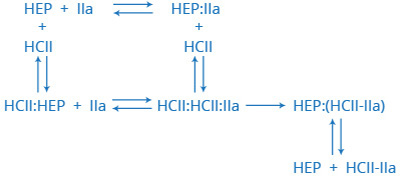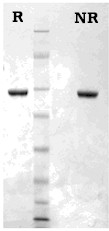Heparin cofactor II (HCII) (heparin cofactor A, antithrombin BM, dermatan sulfate cofactor, human leuserpin-2) is a single chain glycoprotein (Mr=65,600, 10% carbohydrate) member of the serine protease inhibitor (serpin) family (1-3). Amino acid sequence analysis of heparin cofactor II reveals 3 potential N-glycosylation sites and 2 sulfated tyrosines located in two internal repeats of 7 residues located near the NH2-terminal (4-6). The plasma concentration is estimated to be 90 µg/ml (2).
In the coagulation cascade, heparin cofactor II inhibits thrombin by formation of a bimolecular complex in the presence (k2=4.5×108 M-1min-1) and absence (k2=5.0×105 M-1min-1) of heparin (2, 7-9). This complex is stable to denaturants and essentially irreversible. In addition to heparin, a wide variety of polyanionic compounds accelerate inhibition of thrombin by HCII (3). Noteworthy among these compounds is dermatan sulfate, which accelerates inhibition of thrombin by HCII, but not antithrombin III (1,6) This feature has been utilized to develop a plasma based assay specific for heparin cofactor II. Although HCII shows only ~25% sequence homology to other serpins, the reactive site peptide (COOH-terminal 36 amino acids) released on inhibition of thrombin is 53% homologous to that released from antithrombin III (AT III) by thrombin (4,9). The scissile bond in HCII is Leu-Ser which is unusual for an arginine specific protease inhibitor (4,9). In contrast to AT III, the only coagulation protease inhibited by HCII is thrombin, Other proteases inhibited by HCII include α-chymotrypsin, neutrophil cathepsin G and streptomyces griseus protease B (3). The major physiologic role of heparin cofactor II may remain to be discovered.
Heparin cofactor II is prepared from fresh frozen plasma by a modification of the procedure of Griffith, et al., (9). Purity is assessed on SDS PAGE and activity is determined based on thrombin inhibition in the presence of heparin. HCII is supplied in 50% (vol/vol) glycerol/H20 for storage at -20°C.


